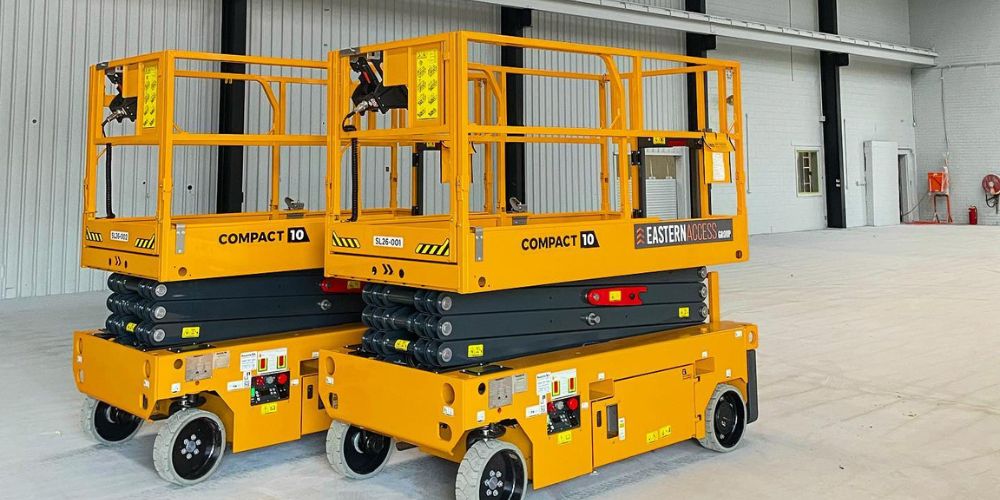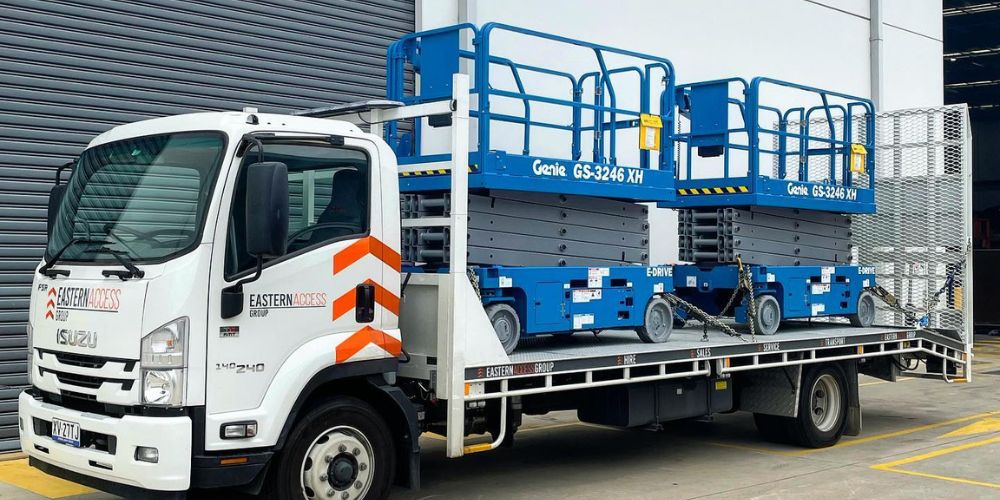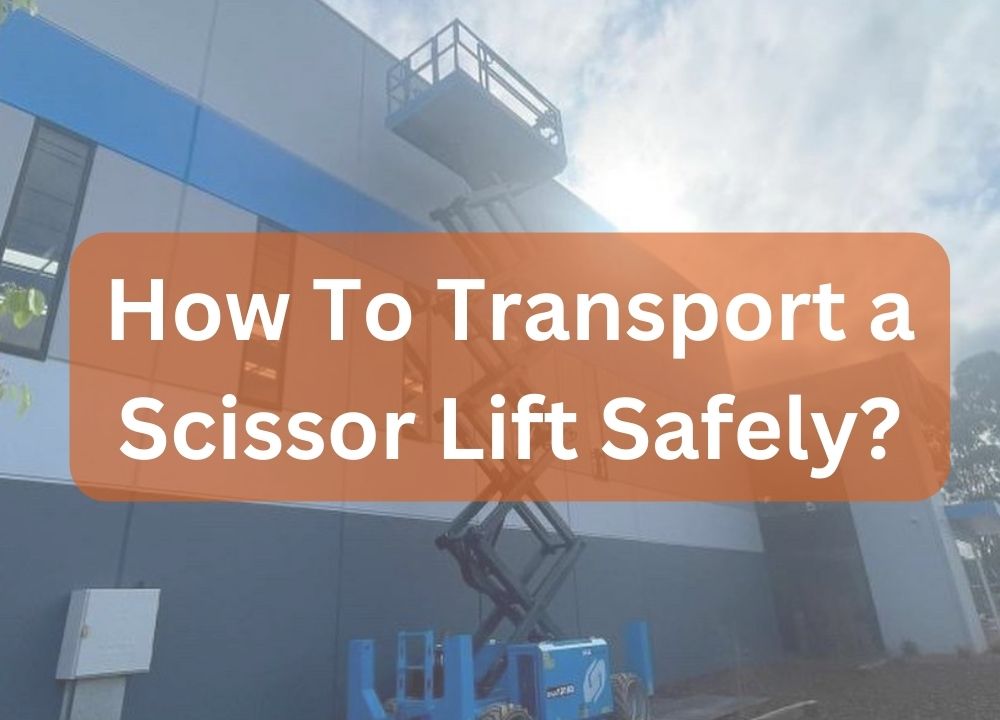How To Transport a Scissor Lift Safely?
If you manage a scissor lift rental business or own one as a contractor, you understand the value of elevated work platform equipment. But what happens if you relocate your scissor lift from one location to another? When they need to relocate their scissor lift from one place to another, most individuals use tilt tray trucks or towing companies.
Transporting a scissor lift is a complex and dangerous task. If not securely secured, a scissor lift might move or tumble during transit, endangering the driver and other motorists. As a result, strict safety precautions must be followed when moving a scissor lift.
Join us as we will guide you through the process of securely transporting a scissor lift in this blog. Everything from examining the lift before transit to unloading it at the destination will get you covered. Through these tips, you can guarantee that your scissor lift is transported securely and effectively.
Table of Contents

What Do You Need During Scissor Lift Transport?
Using appropriate equipment and trucks while moving a scissor lift would be best. Here are some typical alternatives:
Trailer
A scissor lift is commonly transported using a flatbed trailer. Ascertain that the trailer is rated for the lift’s weight and that the lift can be appropriately secured to the trailer. Have the appropriate tie-downs or straps to hold the lift in place during travel.
Truck
A flatbed truck or a box truck can also convey a scissor lift. Check that the truck is rated for the weight of the lift and that it can be properly loaded and unloaded from the truck.
Forklift
To move the scissor lift, a forklift can be used to put it into a vehicle or trailer. Check that the forklift is rated for the lift’s weight and that the lift can be raised and moved safely using the forklift.
Crane
A crane can raise and transfer a scissor lift onto a vehicle or trailer. This is an excellent choice for larger or heavier loads that are difficult to load with a forklift.
How To Transport Your Scissor Lift – Simple Guides To Follow
A scissor lift must be transported carefully to prevent accidents and guarantee that it will be in good operating order when it arrives.
Here are some basic guidelines to follow:
Step #1: Prepare for transport
To transfer a scissor lift securely, examine it for damage, ensure all safety measures are in place, and lower the lift platform to its lowest position. Use straps or chains to secure the lift platform and guardrails to avoid movement during transport. Remove loose things off the lift platform and secure them so they don’t slide off during transfer.
Step #2: Choose the right transport vehicle
When transporting a scissor lift, selecting a transport vehicle appropriate for the lift’s weight and dimensions is critical. This can help prevent accidents and damage to the lift or other vehicles on the road. A trailer or vehicle with a flatbed or lift gate is an excellent option for transporting a scissor lift. Before loading the lift, ensure the transport vehicle is in good shape, with fully inflated tyres and working brakes and lights.
Step #3: Loading the Scissor Lift
Setting a scissor lift appropriately on the trailer is essential to provide stability and avoid accidents. The lift platform should face forwards, and the trailer’s wheels should be centred to distribute the weight equally. Once the lift is in place, it should be fastened with firm and equally distributed tie-downs or straps to avoid moving during transit. Additional supports, such as chocks or blocks, can be added to prevent moving any more, especially if the lift has pneumatic tyres.
Step #4: Driving with Scissor Lifts
Following all traffic rules and regulations, such as adhering to speed limits and traffic signals, is essential when driving with a scissor lift to transport on the road. To prevent tipping or overbalancing, drive gently and steadily when taking turns. Avoid abrupt stops or turns that might tip the lift or cause it to shift. Maintain a safe turning radius to provide yourself room to make unexpected stops or emergency manoeuvres. Check the lift often to ensure it is still sturdy and safe during travel. If you encounter any difficulties, stop right away and make the required adjustments.
Step #5: Unloading the Scissor Lift
It’s essential to place the trailer on the level, stable ground near the unloading spot as possible while unloading a scissor lift. This will make it possible to securely lower the lift to the ground without it toppling or moving. All tie-downs and straps should be taken off the scissor lift after the trailer is in place, ensuring they are not twisted or tangled. The lift should then be raised using the controls on the lift platform to the required height. When it’s time to lower the lift to the ground, do so gently and cautiously. Before releasing the lift controls, ensure the wheels are in touch with the ground.

Importance of Safely Transporting a Scissor Lift
Scissor lift transportation may be difficult and sometimes dangerous. Therefore, it is crucial to take the required safety procedures to guarantee that the elevator is delivered to its destination without incident. The following are some justifications for why it’s crucial to move a scissor lift securely:
Avoid mishaps
A scissor lift improperly secured during transit may move or topple over, resulting in collisions and injury to the driver and other drivers.
Protect the lift
By securely fastening, the scissor lift can avoid physical harm during transit, such as scratches, dents, or damaged pieces.
Protect other vehicles
An unstable scissor lift may be a severe danger to other drivers on the road, leading to collisions and harm to other cars.
Compliance to regulations
Federal, state, or municipal laws might be broken while transporting a scissor lift improperly, which can result in penalties and fines.
Reduces costs and time.
Safe scissor lift transportation may save time and money by preventing accidents and damage to the scissor lift or other vehicles, lowering maintenance costs, and minimising downtime.
What is a Scissor Lift, By the Way?
A scissor lift is a platform to raise people, machinery, or supplies to a certain height. It consists of a platform installed on many metal supports that cross one another and extend and retract in a scissor-like manner to raise and lower the platform.
Scissor lifts are frequently used in construction, maintenance, and industrial settings to paint, install electrical fixtures, change light bulbs, and reach high shelves or storage places. They can be driven by electricity, hydraulics, or compressed air. Scissor lifts are available in various shapes and sizes, including indoor and outdoor models, narrow or broad platforms, and types made for uneven terrain or rough surfaces.
Frequently Asked Questions
It is determined by the weight and size of the lift, as well as the state or province through which it is being transported. Oversize or overweight licences are required in several states for loads that exceed specific weight or size limitations. Always check with your state’s Department of Transportation to see if special permissions are required.
If you have a technical problem or an accident while carrying a scissor lift, stop the vehicle immediately and contact a skilled technician or emergency services if necessary. If you are not fully trained and competent, do not attempt to remedy the problem yourself.
Before each trip, you should examine your scissor lift to verify that it is in good working order and adequately secured. Accidents and damage to the lift and other vehicles can be avoided with regular inspections.
The weight and size of the scissor lift determine this. Some scissor lifts are small enough to transport on a standard trailer, while bigger lifts may require a flatbed or lowboy trailer. Before choosing a transport vehicle, always consider the weight and size of the lift.
Conclusion
To properly transfer a scissor lift, examine it, secure the platform and guardrails, and remove any loose goods. Drive gently and cautiously, obey traffic regulations, and inspect the lift regularly. Ensure the ground is firm and level during unloading, and always follow correct procedures. Proper safety practices are crucial to ensuring the safety of the lift, the driver, and other road users. Always follow established safety measures and recommendations to avoid accidents and guarantee safe transportation.
Call a professional technician or the lift manufacturer for assistance if you have any difficulties or questions. These easy tips ensure that your scissor lifts are safe and effective shipping.

